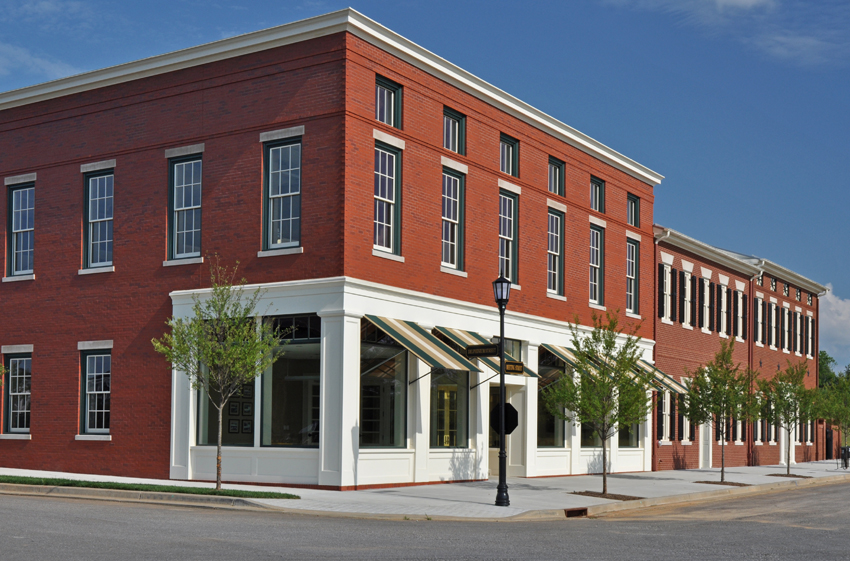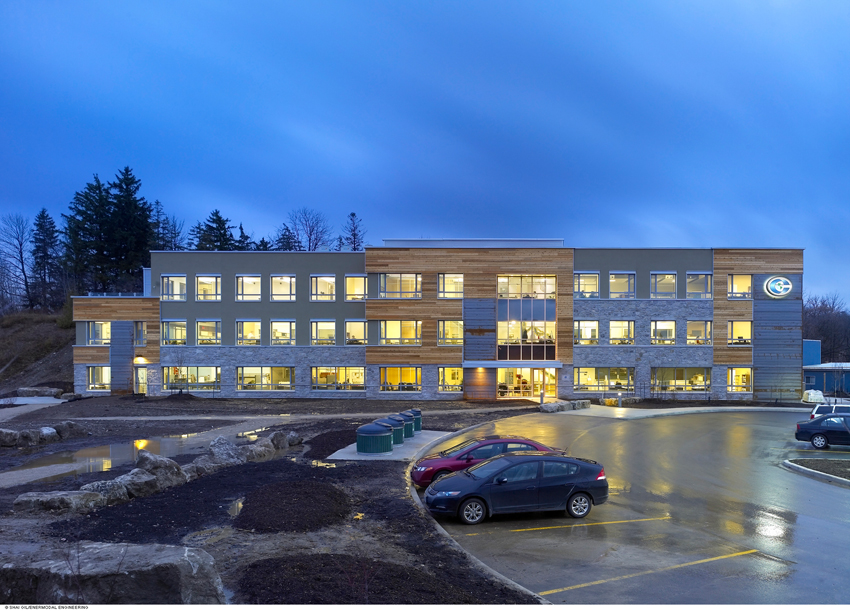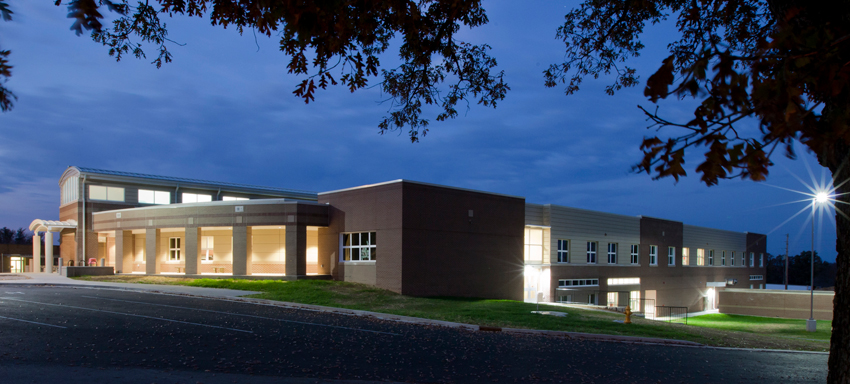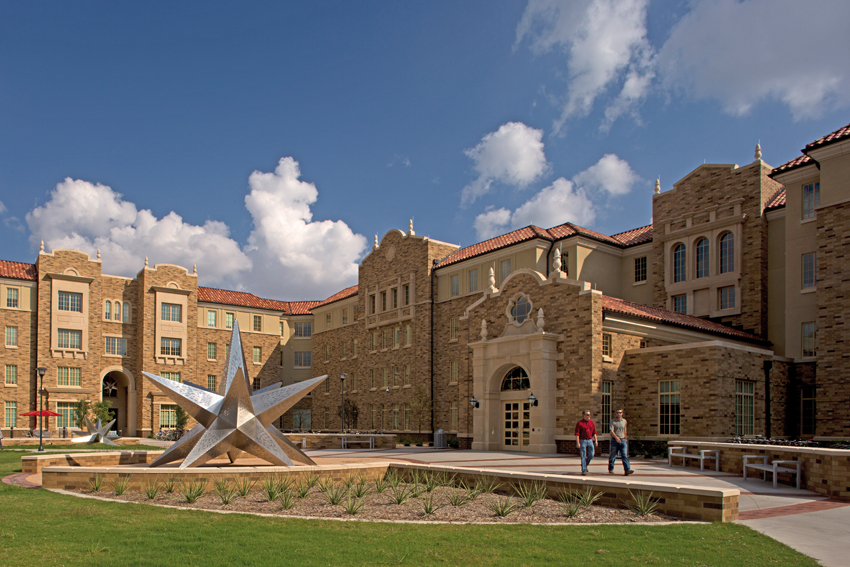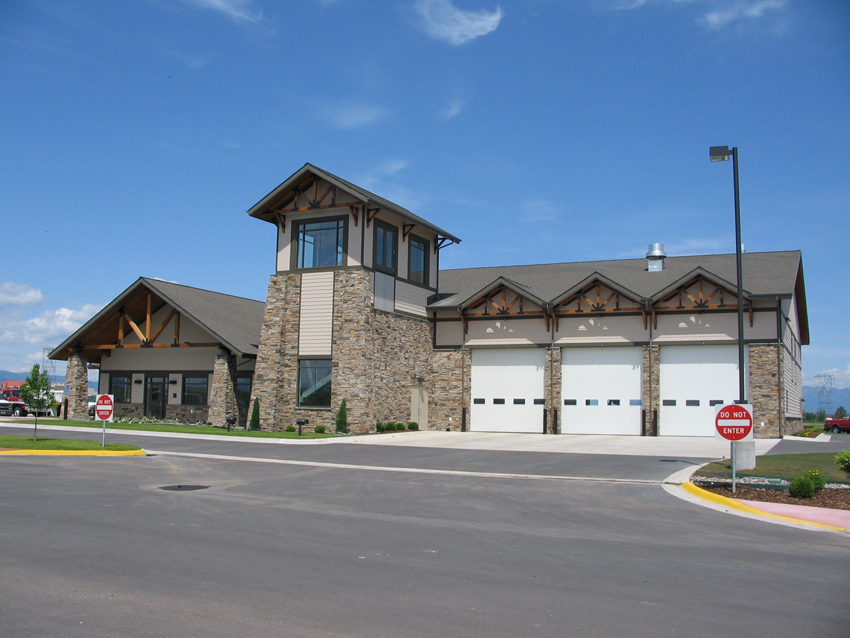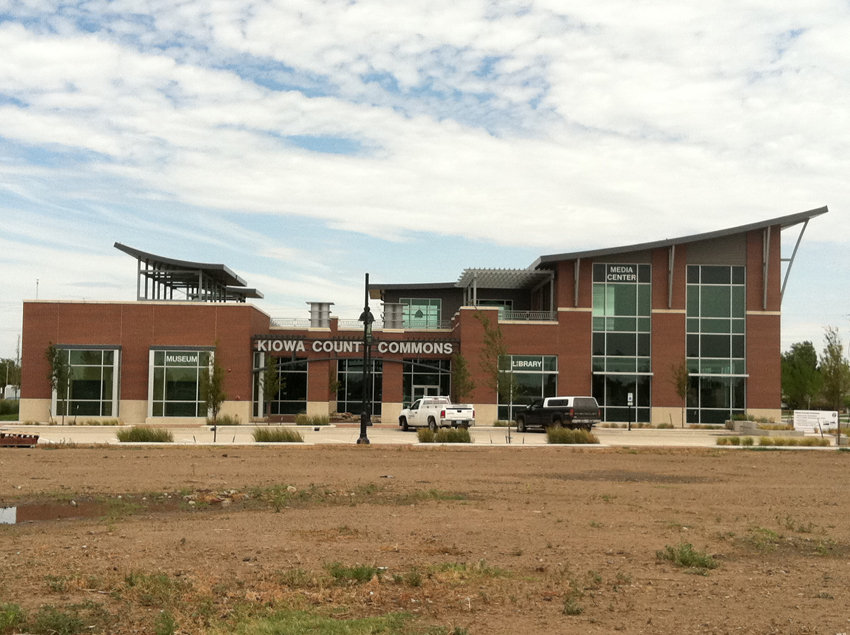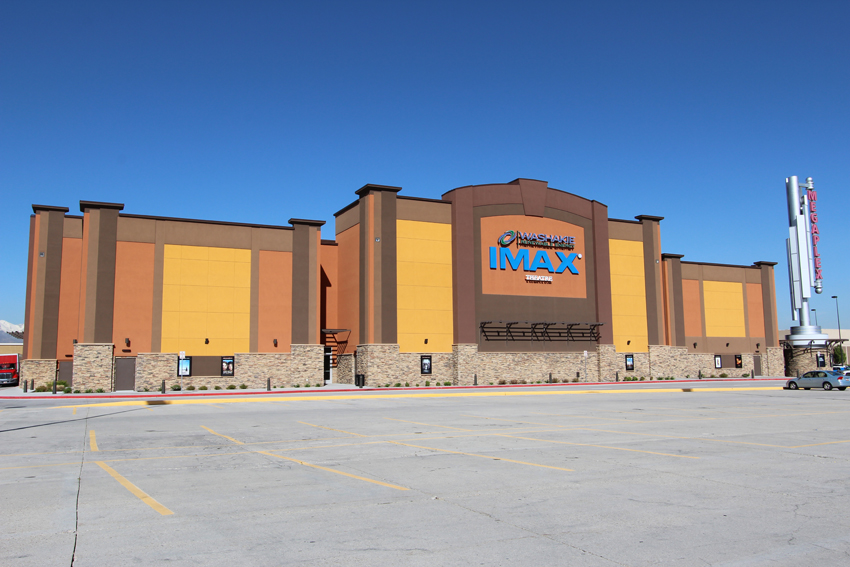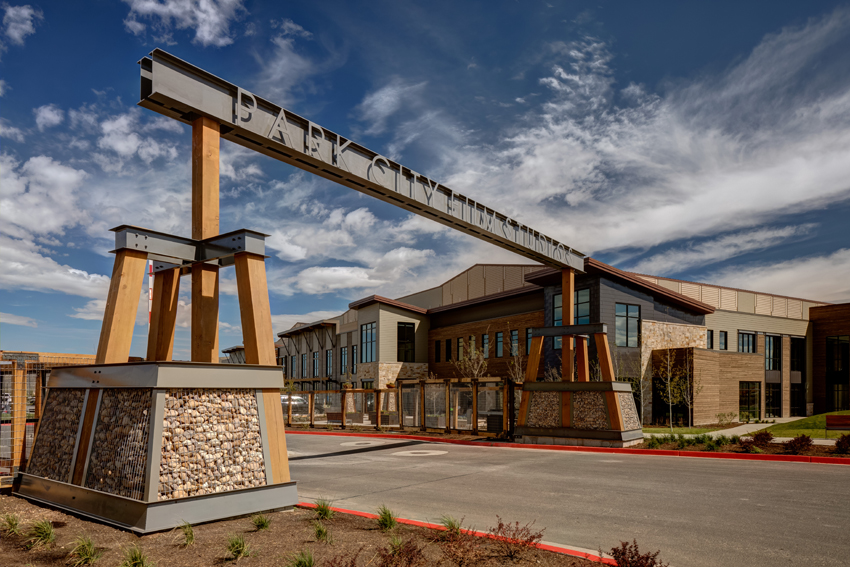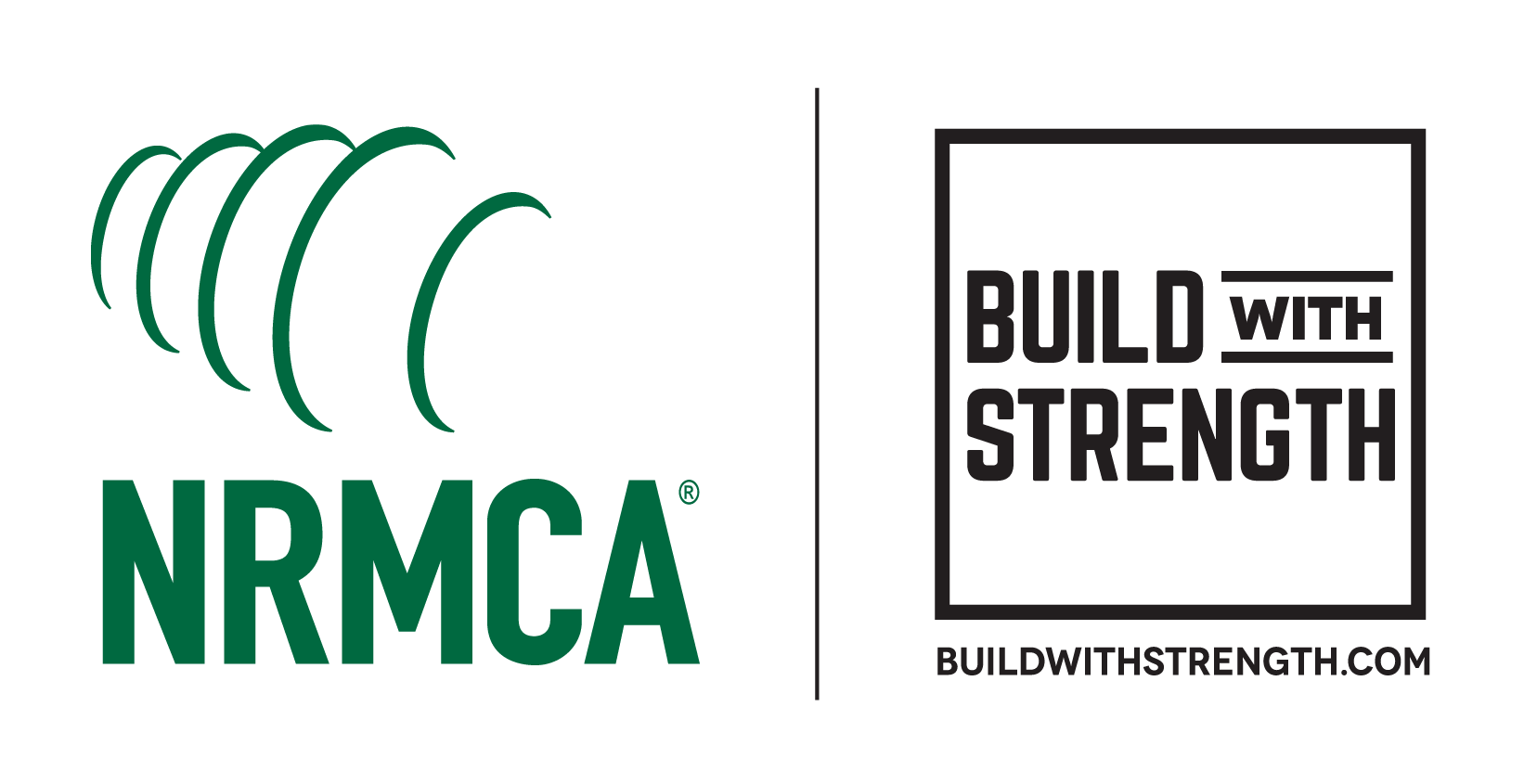This CE Center article is no longer eligible for receiving credits.
Insulating concrete forms (ICFs) are emerging as the building system of choice for commercial construction. ICFs combine two well-established building products: reinforced concrete for strength and durability, and expanded polystyrene (EPS) insulation for energy efficiency. What makes ICFs different is that in traditional construction, the structural walls are installed first, and then insulation is attached to the walls. For ICFs, the process is reversed. The forms, which are made of rigid insulation, are installed first, and then the reinforcing steel and concrete are placed into the forms. The forms remain in place to provide the high-efficiency thermal, air, and moisture barriers.
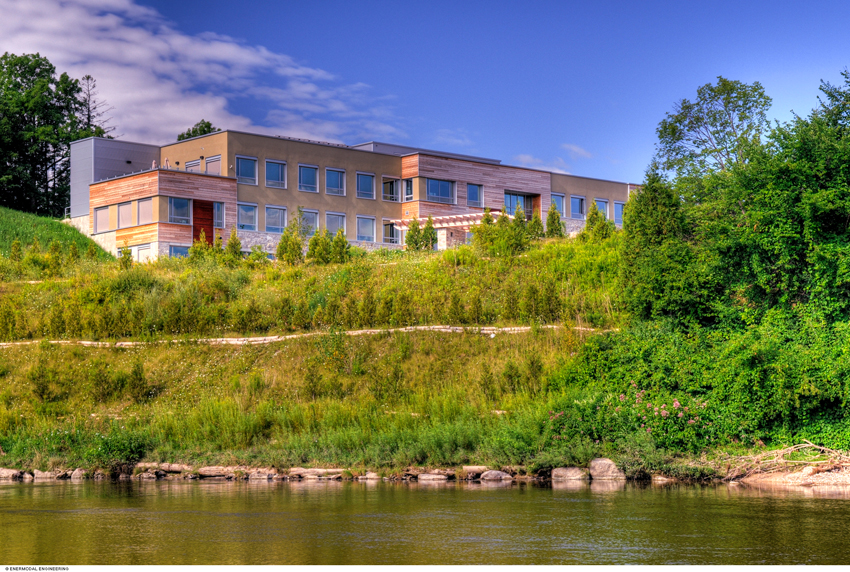
Photo courtesy of Nudura and Enermodel Engineering
Enermodal Engineering built its new headquarters in Kitchener, Ontario, Canada, using an extremely airtight and well-insulated building envelope comprised of insulated concrete forms (ICFs). It is now the most energy-efficient office building in Canada.
Most buildings constructed in North America are low- to mid-rise buildings using bearing-wall construction. This means there are exterior and interior walls that are designed to carry the vertical loads and the floors span between the bearing walls. Often the bearing walls also serve to resist lateral loads from wind and earthquakes. ICF wall systems have been used for bearing-wall buildings ranging from single-story to high-rise buildings up to 30 stories tall and everything in between.
There are examples of ICF buildings all over the United States and Canada, including single-family residential, multifamily residential, hotels, dormitories, assisted living facilities, offices, health-care facilities, manufacturing, and warehouse buildings. Schools built with ICFs are popular due to low- or net-zero energy use. Theaters are also trending toward ICF construction for superior sound attenuation. For this course, we will focus on commercial applications, including offices, schools, retail, and institutional buildings.
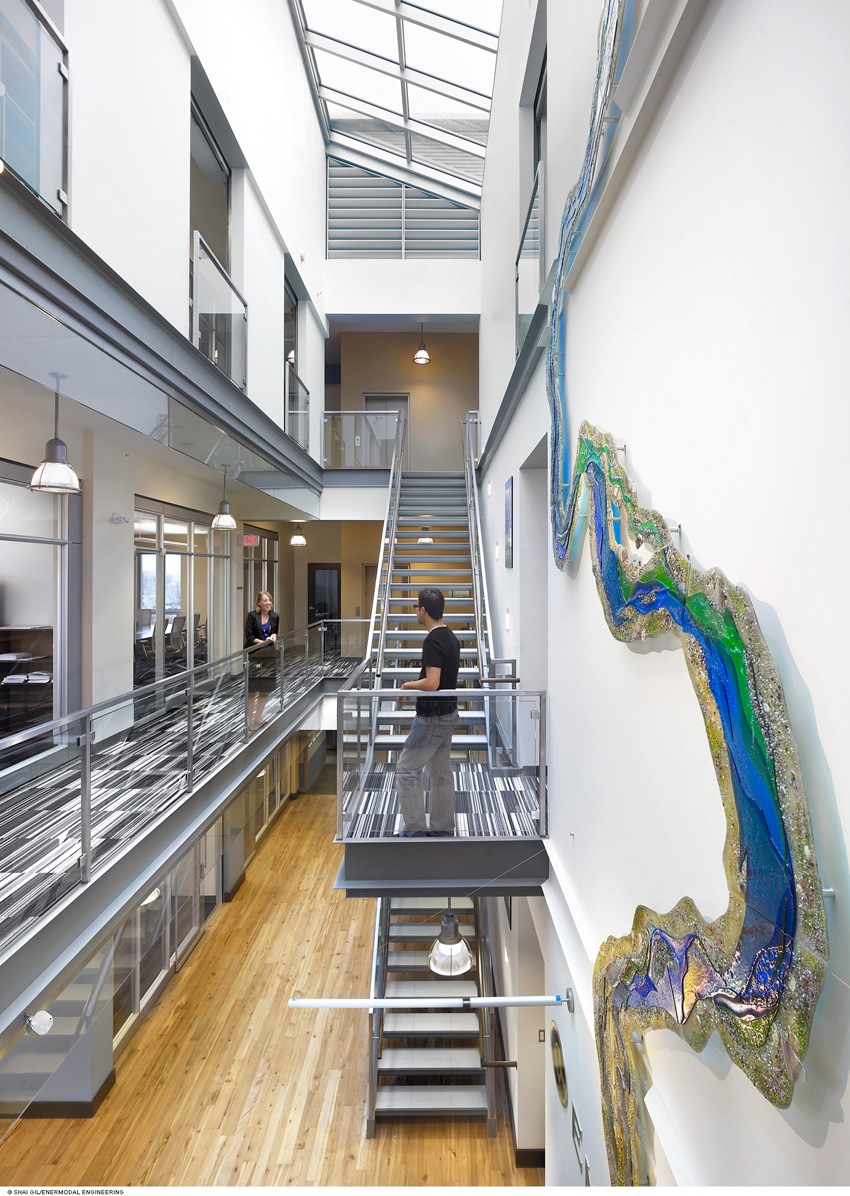
Photo courtesy of Nudura and Enermodel Engineering
Enermodal Engineering created a new headquarters building that is quiet, comfortable, and healthy for employees.
ICF Wall Systems
The efficient construction process is what sets ICF building systems apart from other building systems, such as wood frame, steel frame, and masonry construction.
ICF construction can help contain construction costs and reduce construction time because of the inherent efficiencies of the installed assembly that serves nine functions:
- Concrete form (that stays in place)
- Thermal barrier
- Air barrier
- Moisture barrier
- Fire barrier
- Sound barrier
- Substrate for running utilities
- Substrate for attaching finish materials
- Reinforced-concrete structure
In other forms of construction, these functions are installed by several different trades, usually at significantly added cost. General contractors can realize a number of on-site efficiencies, including fewer trades, reduced crew size, and accelerated construction schedules. Because construction schedules are usually much shorter with ICF construction, the general contractor is able to finish on time and within budget. The building owner is able to put the building into service sooner, cutting short the financing costs and initiating a quicker revenue flow.
Insulating concrete forms (ICFs) are emerging as the building system of choice for commercial construction. ICFs combine two well-established building products: reinforced concrete for strength and durability, and expanded polystyrene (EPS) insulation for energy efficiency. What makes ICFs different is that in traditional construction, the structural walls are installed first, and then insulation is attached to the walls. For ICFs, the process is reversed. The forms, which are made of rigid insulation, are installed first, and then the reinforcing steel and concrete are placed into the forms. The forms remain in place to provide the high-efficiency thermal, air, and moisture barriers.

Photo courtesy of Nudura and Enermodel Engineering
Enermodal Engineering built its new headquarters in Kitchener, Ontario, Canada, using an extremely airtight and well-insulated building envelope comprised of insulated concrete forms (ICFs). It is now the most energy-efficient office building in Canada.
Most buildings constructed in North America are low- to mid-rise buildings using bearing-wall construction. This means there are exterior and interior walls that are designed to carry the vertical loads and the floors span between the bearing walls. Often the bearing walls also serve to resist lateral loads from wind and earthquakes. ICF wall systems have been used for bearing-wall buildings ranging from single-story to high-rise buildings up to 30 stories tall and everything in between.
There are examples of ICF buildings all over the United States and Canada, including single-family residential, multifamily residential, hotels, dormitories, assisted living facilities, offices, health-care facilities, manufacturing, and warehouse buildings. Schools built with ICFs are popular due to low- or net-zero energy use. Theaters are also trending toward ICF construction for superior sound attenuation. For this course, we will focus on commercial applications, including offices, schools, retail, and institutional buildings.

Photo courtesy of Nudura and Enermodel Engineering
Enermodal Engineering created a new headquarters building that is quiet, comfortable, and healthy for employees.
ICF Wall Systems
The efficient construction process is what sets ICF building systems apart from other building systems, such as wood frame, steel frame, and masonry construction.
ICF construction can help contain construction costs and reduce construction time because of the inherent efficiencies of the installed assembly that serves nine functions:
- Concrete form (that stays in place)
- Thermal barrier
- Air barrier
- Moisture barrier
- Fire barrier
- Sound barrier
- Substrate for running utilities
- Substrate for attaching finish materials
- Reinforced-concrete structure
In other forms of construction, these functions are installed by several different trades, usually at significantly added cost. General contractors can realize a number of on-site efficiencies, including fewer trades, reduced crew size, and accelerated construction schedules. Because construction schedules are usually much shorter with ICF construction, the general contractor is able to finish on time and within budget. The building owner is able to put the building into service sooner, cutting short the financing costs and initiating a quicker revenue flow.
There are many different ICF manufacturers with similar ICF systems. The blocks range in size from 48 to 96 inches long and 12 to 24 inches high depending on the manufacturer. The most common configuration of an ICF unit is made up of two layers of 23⁄8-inch to 23⁄4-inch-thick EPS insulation spaced 4, 6, 8, 10, or 12 inches apart depending on design requirements. The most common spacing is 6 or 8 inches for most low- to mid-rise buildings, but for taller buildings, taller walls, or exceptionally large loadings, thicker walls are necessary. For simplicity, ICFs are generally called out by the width of cavity. Hence, an ICF with a 6-inch cavity is called a 6-inch ICF, an ICF with an 8-inch cavity is called an 8-inch ICF, and so forth.
ICF manufacturers have a variety of ICF blocks to accommodate any design condition and have outstanding technical support, including design manuals, design details, engineering support, and all of the test reports needed for commercial construction, including fire, energy, and noise. They also have special components, including straight blocks, corner blocks, brick ledges, angled blocks, curved blocks, and half-height units, minimizing the need for field modifications that further reduce construction time.
Another benefit of ICFs is that construction projects can continue through the coldest and hottest weather because of the insulating quality of the ICF forms. This means that concrete will continue to gain strength within the protective formwork despite freezing conditions and not overheat during extreme summer conditions.
In general, ICF construction costs are about the same as wood, steel, or masonry construction, but because of the reduced construction time of ICF construction, ICFs usually win out. Building with large ICF units instead of individual small framing elements such as dimensioned lumber or cold-formed steel studs saves on initial cost.
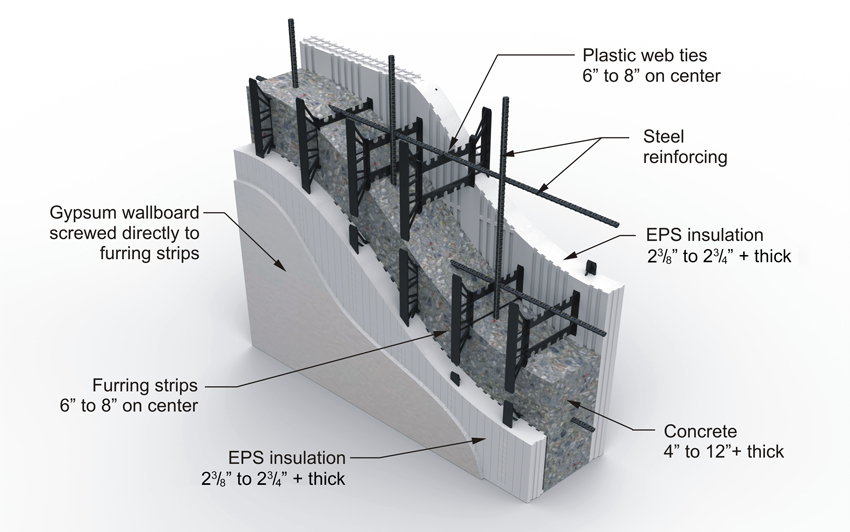
Shown is a typical ICF wall panel.
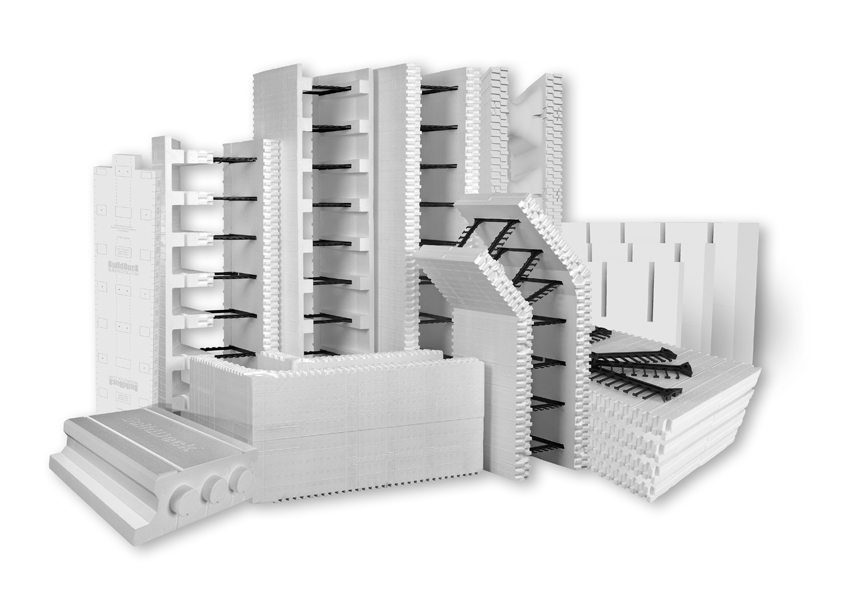
Image courtesy of Logix (top); Image courtesy of BuildBlock (bottom)
Shown are ICF wall and floor components.
Floor Systems
In addition to ICF walls, there are also ICF concrete floor and roof systems. The concept is similar in that the ICF form is made with rigid insulation to function as a one-sided form at the bottom surface. The forms are installed to span between concrete walls, reinforcing steel is placed, and then concrete is placed over the forms. The result is a reinforced-concrete floor or roof with rigid insulation on the bottom. Other types of floor systems often used in combination with ICF walls include precast hollow-core plank and composite concrete floors over steel joists.
Construction Process
The construction process is simple, which is why ICF construction is so cost-effective and helps reduce construction time. Once the foundation or structural floor is in place, the following process is followed:
- Step 1: ICFs are stacked in the shape of the wall, and openings for windows and doors are formed using bucks made of treated wood or plastic.
- Step 2: Steel reinforcing is placed into the forms and secured in place.
- Step 3: Bracing and scaffolding are installed to keep the wall straight, plumb, and secure and to provide a working platform.
- Step 4: Concrete is pumped into the forms.
- Step 5: Electrical and plumbing lines are installed into the EPS by cutting channels with a hot knife or other tool.
- Step 6: Interior and interior finish is installed directly to the ICFs by screwing into the embedded plastic furring strips.
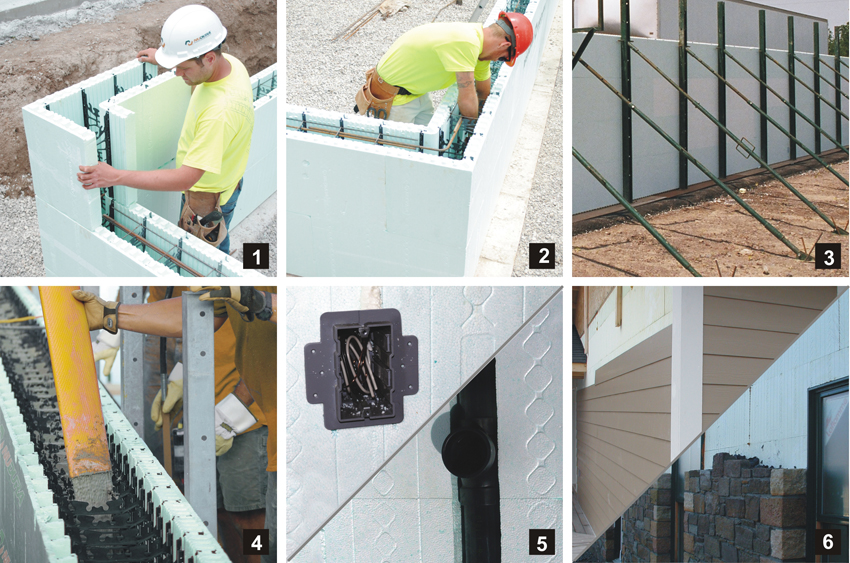
Images courtesy of Nudura
Shown is the six-step construction process for ICF walls.
When building multistory buildings, the walls are generally erected and cast one story at a time. Structural floors are installed and finished before continuing with walls on the next level. There are also examples of walls being placed several stories at a time and installing structural slabs later. Some contractors have panelized ICF walls off-site to further reduce construction time. Others are beginning to use steel fibers in place of horizontal shrinkage and temperature reinforcement, which can also significantly reduce construction time.
With these cost and schedule advantages, along with fire safety, durability, and energy efficiency, ICFs are quickly becoming the system of choice for commercial construction of all types, including office buildings, schools, hospitality, and institutional buildings.
Office Buildings
Many office buildings are owner occupied, so operating efficiency, low maintenance, and long-term value are key attributes for a building system. This is why many building owners are turning to ICFs. The low cost and reduced construction schedule of ICFs are attractive, but the fact that ICF buildings offer the most energy-efficient design option is a key factor in selecting ICFs. In addition, owner/tenants often like to offer their employees healthy buildings and demonstrate their commitment to sustainability by achieving LEED certification.
The energy codes, IECC and ASHRAE 90.1, consider ICFs to be mass walls with continuous insulation. Typical whole-wall ICF assemblies have an R-value ranging from R-24 to R-26 or even higher depending on the manufacturer. Because thermal mass reduces temperature swings and delays heat transfer, there are fewer spikes in temperature inside an ICF building. Thermal mass shifts energy demand to off-peak time periods when utility rates are lower, reducing costs further. Since the mass buffers indoor temperature fluctuations, it also contributes to improved occupant comfort.
The other benefit of ICF walls is that they are more airtight than wood- or steel-frame construction. In many cases, the air-infiltration rates are as low as 0.5 air changes per hour. Because there are no studs to interrupt the insulation, thermal bridging is eliminated, further improving energy performance. Another key factor in lowering construction cost is the ability to downsize the HVAC system. Energy analysis and building owner experience suggest energy savings with ICFs ranging from 20 percent to as much as 50 percent, depending on other energy-efficiency strategies employed for the building.
Education
Protecting children’s health, safety, and welfare along with providing comfortable learning environments are important factors when building a new school. Reinforced concrete and polystyrene, the two main components of ICFs, are inert and do not off-gas like other building materials, making them ideal for school buildings. The combination of insulation and thermal mass results in a building with more consistent temperature, which vastly improves occupant comfort. In addition, concrete and polystyrene are noncombustible, which means schools are safer.
Concrete is the most fire resistant of all construction materials used today, which means ICF construction offers a significant safety advantage over wood- and steel-frame construction. Concrete cannot burn like wood or soften and bend like steel under fire conditions. All ICF manufacturers involved in commercial construction have tested their products in accordance with standard fire-testing protocol, including ANSI/UL 263 and ASTM E119. Typically, 4-inch ICF walls achieve a 2-hour fire rating, 6-inch ICF walls achieve a 3- or 4-hour fire rating, and 8-inch and thicker ICF walls exceed a 4-hour fire rating. Generally the assemblies tested include reinforced concrete with a minimum compressive strength of 2,900 psi and 1⁄2-inch gypsum wall board on each side.
The EPS used in ICFs is flame retardant and approximately five times better than wood at stopping flame spread from materials burning in close proximity. EPS is completely unable to support a flame without an outside flame source. This is what provides the extra margin of safety for occupants and firefighters over wood and steel construction. EPS used for ICFs is strictly required to have a flame spread index of less than 25 and smoke developed rating of less than 450 when tested in accordance with ASTM E84 & ANSI/UL 723. ICF companies that maintain national evaluation reports from ICC-ES or other accredited testing agencies have all conducted a long list of materials tests to comply with national safety standards.
Institutional Buildings
Hospitals and clinics, police stations, fire stations, and other government buildings have one thing in common: they need to survive disasters and last for a long time. This is why many communities are turning to ICF construction, since reinforced concrete has long been the material of choice to resist extreme structural loading from wind, earthquakes, floods, and fires. Many ICF buildings have survived disasters while surrounding buildings with less-durable materials have been completely destroyed.
Because ICF walls are integral with a concrete floor and roof system, they are extremely resistant to high loading and provide significant structural redundancy to avoid catastrophic failure. The solid walls act as shear walls to resist wind and earthquake loading. They also provide protection from flying debris caused by hurricanes and tornadoes. Because concrete and EPS are water resistant, even when a building is subject to flooding, the structure survives. This property protection is vital for communities to withstand and recover from disruptive events.
ICF walls are designed using traditional design requirements of the ACI 318 Building Code. This means that architects and engineers can use the same analysis and design techniques used on traditionally formed concrete buildings.
Entertainment/Hospitality
Safety is always a key concern in structures such as entertainment and hospitality buildings where large crowds of people gather. Fire safety is likely the main reason to select concrete for these types of structures. However, in addition, noise and vibration are also concerns for entertainment and hospitality buildings such as theaters, hotels, and convention centers.
Concrete walls and floors offer the best solution to control noise and vibration. Nothing is worse than hearing someone with their TV blaring in the hotel room next door or the deafening sound from the action movie in the theater next to yours. This is why ICFs are often used for entertainment and hospitality projects for their ability to isolate and dissipate noise. The fact that ICFs can nearly eliminate sound transmission at virtually no additional cost makes them very attractive for any project in which peace and quiet is a selling point.
The concrete core of ICFs offers excellent noise control in two ways. First, it effectively blocks airborne sound transmission over a wide range of frequencies. Second, concrete effectively absorbs noise, thereby diminishing noise intensity. Because of these attributes, ICF walls and floors have been used successfully in entertainment and hospitality applications. Six-inch ICF walls easily achieve a sound transmission classification (STC) rating of 55. Higher STC ratings up to STC 70 can be achieved with additional gypsum wallboard or special isolation channels. For concrete floors, most meet STC 50 or higher and an impact insulation class (IIC) of 50 or higher depending on the floor and ceiling finish.
Conclusion
ICF systems result in construction that is faster, easier, and less labor intensive than other construction methods, such as wood or steel framing. ICFs are lightweight, durable, and offer a system that requires less skilled labor. The system combines the reinforced-concrete structural system along with the thermal, air, and moisture barrier in one step, which reduces the number of trades required on-site. Construction can continue all year long since the forms provide an ideal curing condition for concrete during the hottest and coldest weather.
Because the forms stay in place after concrete is poured, there is no need for labor-intensive wood, aluminum, and steel formwork that requires large cranes and other expensive hauling equipment. ICFs are user friendly, which means that construction crews new to the system can learn the method quickly. Many crews are familiar with the running-bond stacking method used in masonry construction, but instead of stacking small, heavy blocks with wet mortar, they are installing large blocks made with polystyrene, meaning crews can install more wall area per day.
All this leads to a construction system that is ideal for today’s competitive construction environment. ICFs are a modern building system that is easy to use, cost competitive, and meets modern building codes for structural loading, fire, energy, and noise.






